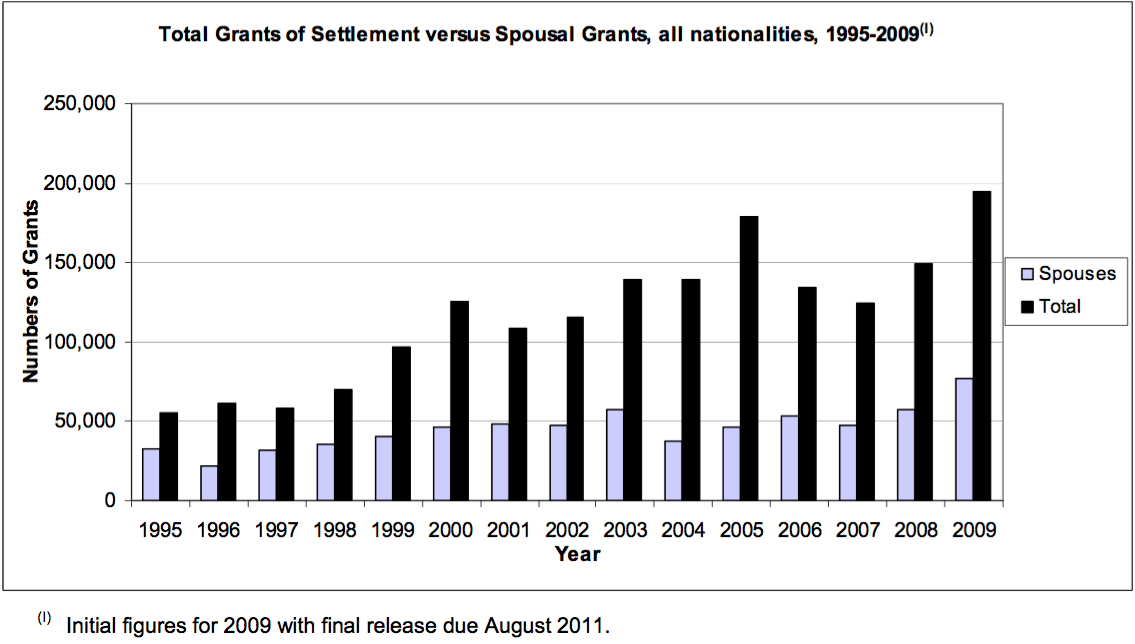- BY Free Movement

New research paper on marriage immigration
THANKS FOR READING
Older content is locked

A great deal of time and effort goes into producing the information on Free Movement, become a member of Free Movement to get unlimited access to all articles, and much, much more
TAKE FREE MOVEMENT FURTHER
By becoming a member of Free Movement, you not only support the hard-work that goes into maintaining the website, but get access to premium features;
- Single login for personal use
- FREE downloads of Free Movement ebooks
- Access to all Free Movement blog content
- Access to all our online training materials
- Access to our busy forums
- Downloadable CPD certificates
The Home Office have published a new piece of research they commissioned, entitled Marriage-related migration to the UK, by Katharine Charsley, Nicholas Van Hear, Michaela Benson and Brooke Storer-Church.
It makes very interesting reading for anyone interested in immigration policy and in the history of spousal immigration. There are a number of graphs representing numbers of grants of settlements to spouses of different nationalities, for example, and while there is an overall upward trend the two stand out features are (1) that the increases are way below the general increase in migration to the UK, meaning that spouses now make up 40% of the total compared to 59% in 1995 and (2) that there are peaks and troughs, which can tentatively be correlated with certain changes in immigration rules.
The final paragraphs of the report are thought-provoking and ought to give the Government pause for thought before they rush into making the changes proposed in the current family immigration consultation:
The fact that spousal settlement, although still increasing, has not kept pace with increases in other forms of migrant settlement suggests that successive new restrictions on marriage-related migration may have had some impact – although such effects are hard to disentangle from the effects of EU expansion.
It is also clear, however, that changes in immigration regulations (whether or not directed at family migration) can have unforeseen consequences for marriage-related migration, and sometimes negative impacts on migrants and their families. Qualitative research on the effects of 1962 Commonwealth immigration restrictions documents their part in transforming previously predominantly male, temporary/circular migration from Pakistan into family reunification and settlement, by reducing alternative entry routes, and opportunities for circular migration (e.g. Shaw 2000: 30-7). The recent raising of the minimum age for both migrant and sponsoring spouses to 21 was portrayed as combating coerced marriages of the young, but other research raises the fear that young people may still be forced into marriage, but kept abroad until they reach the age at which they can sponsor their spouse (Hester et al., 2008), whilst young couples whose marriages were demonstrably not contracted under duress complained at enforced separation.20 Recent Danish research has also traced unintended effects of their new restrictions on spousal migration. Increased minimum ages, a ‘combined attachment’ regulation requiring couples demonstrate greater ties to Denmark than to the country of residence of the other spouse, and other restrictions, may have led some to postpone rather than avoid transnational marriage; to an increase in unregulated religious marriages; and created new communities of cross-border marital commuters in neighbouring Sweden where spousal immigration requirements are more lenient (Schmidt et al., 2009). If the UK follows its European neighbours in tightening controls on marriage-related migration, the lack of a more complete and balanced evidence base on this diverse form of immigration may increase the risk of further unforeseen consequences resulting from new legislation. Substantial new empirical research in this numerically important and dynamic field is thus urgently needed.
SHARE



4 responses
“may increase the risk of further unforeseen consequences”
“enforced separation”
“transforming …temporary/circular migration…….into family reunification and settlement ,by reducing alternative entry routes.”
The numbers and final paragraph speak clearly and reflect what many have said on this site.
Over-regulation on the matter damages too many families in only temporarily reducing/deffering marriage or family immigration
I suspect that the fall between 2003 & 2004 is misleading. Many who wanted to get married but couldn’t under the COA restrictions, obtained an unmarried partner Visa instead. I forget which year the probationary period changed from 1 to 2 years, but that would have a similar effect on the data.
It will be interesting to see the 2011 figures, the 5th year since EU Regs 2006, the level of marriage based PR issued.
I fully agree with Mr T about over-regulation. It will also be interesting to see how many British/non-EEA couples either live in another EEA state in order to avail themselves of ECJ Singh or live in the country of citizenship of the other spouse.
It would be ideal if Zambrano were expanded by the ECJ to provide spouses of citizens with a right of residence similar to that for spouses of EEA nationals, subject only to a genuine marriage, because in a society where people are free to form families with whoever they choose, that should be the only criteria.
Mutly – thanks.
“if Zambrano were expanded”
If married couples had children to utilise Zambrano, would the Residency appear under “Marriage Immigration” or “Family Immigration” or under “Others” in these form of statistics in the future? Would it be different if the ECJ extended Zambrano as you propose?
If an applicant is granted in-country under Zambrano or ZH (Tanzania) it would be discretionary leave, so although I’m not sure, I suspect it would come under “others”.
If the ECJ extends Zambrano in the future to the extent that it essentially gives a right of residence to parents and potentially spouses then I suspect the immigration rules would need to be adjusted accordingly and applications would come under family/marriage. With the HO still not having responded to Zambrano, and with questions pending at the ECJ from other member states, I suspect there will in future be more clarity on when it applies and if policy isn’t eventually adjusted, courts will enforce it.